A Risk-Based Model for Real-Time Flood Control Operation of a Cascade Reservoir System under Emergency Conditions
Abstract
:1. Introduction
2. Methodology
2.1. Emergency Scenarios Establishing
- (1)
- An earthquake triggers the upstream dam break. The upstream dam break causes a dam break flood for the downstream reservoir. The dam break flood is calculated using the Dam Breach Analysis model (DB-IWHR) proposed by Chen et al. [22]. The DB-IWHR can produce reservoir outflow hydrograph by conducting dam breach analysis. DB-IWHR improves the traditional dam breach model in the aspects of broad-crested weir flow analysis, incipient velocity, and shear stress of erosion, soil erosion and breach lateral enlargement model. Chen et al. also developed a transparent spreadsheet (DB-IWHR 2014) for the model, which is coded in Microsoft Excel and VBA (Visual Basic for Applications) programming. The spreadsheet and the user manual for detailed information can be downloaded from the website [23].
- (2)
- Extreme floods include 100-year return period design flood, 1000-year return period design flood and 10,000-year return period design flood.
- (3)
- Some spillways of a dam do not work. As a consequence, the release capacity of the reservoir is reduced.
2.2. Monte Carlo Simulations
2.2.1. Uncertainties
2.2.2. Reservoir Flood Control Operation Models under Emergency Scenarios
- (1)
- They should ensure the safety of the dam: The reservoir water level cannot exceed the dam crest elevation in the real-time flood control operation of the cascade reservoirs; the emergency responses should maximize the safety of the reservoirs and reduce the risk of sequent dam failures in cascade reservoirs.
- (2)
- The emergency responses should ensure the safety of the downstream city. The maximum flood discharge should not exceed the safety discharge at the downstream control point. If this requirement cannot be guaranteed, then the time duration that the flood discharge exceeds the safety discharge should be minimized in order to reduce the social and economic loss of the downstream city.
- (3)
- If the sequent failures of the dams in the cascade system are inevitable, then the main purpose of the emergency response should be postponing the time that the reservoir overtopping occur as much as possible. In doing so, the decision-makers and the government can have more time to evacuate people and property to reduce the social and economic loss.
- (1)
- Release capacity model
- (2)
- Safety discharge model
- (3)
- Zero release model
- (4)
- Command model
2.2.3. Monte Carlo Simulation Considering the Combination of Emergency Scenarios and Uncertainties
- (1)
- Obtain the forecasted inflows () of the reservoirs under the proposed emergency scenarios;
- (2)
- Obtain the probability distributions of the forecast errors ();
- (3)
- Generate the random samples of the forecast errors () using the Latin Hypercube Sampling method;
- (4)
- Calculate the random samples of the stochastic reservoir inflows (), according to Equation (2); and
- (5)
- Calculate the random samples of the reservoir water levels, storages and discharges through reservoir flood routing. The reservoir flood routing is conducted using the proposed emergency operation models.
2.3. Risk Analysis
3. Case Study
3.1. Study Area
3.2. Data and Parameters
3.2.1. Data and Parameters for the Scenario of Upstream Dam Break
3.2.2. Data and Parameters for the Scenario of Extreme Flooding
3.2.3. Data and Parameters for the Scenario of Spillway Failure
4. Results
4.1. The Results for the Scenario of Upstream Dam Break
4.1.1. The Results Using the Release Capacity Model
4.1.2. The Results Using the Command Option
4.2. The Results for the Scenario of Extreme Flooding
4.3. The Results for the Scenario of Spillway Failure
5. Discussion
6. Conclusions
- (1)
- We considered the emergency events including the upstream dam break triggered by an earthquake, extreme floods and failure of some spillways of a reservoir and the uncertainty of reservoir inflows.
- (2)
- We developed a risk-based model for real-time flood control operation of reservoirs under the combination of these emergency conditions and uncertainties.
- (3)
- We calculated the risk of reservoir overtopping of a reservoir under the combination of an emergency condition and uncertainties. We suggested the maximum initial water levels of a reservoir for each operation model in order to avoid the risk of reservoir overtopping.
- (4)
- We applied the proposed model to the cascade reservoir system in the upper reaches of Daduhe river basin in China. The results show that the integrated risk of the reservoir increases with the initial reservoir water level, increases with the uncertainty degree of the reservoir inflows, increases with the return period of the extreme floods, and also increases with the reduced percentage of the reservoir release capacity. The maximum initial water level of the Shuangjiangkou reservoir is 2447 m a.s.l. using the release capacity model and is 2444.5 m a.s.l. using the command model under the scenario of upstream dam break. The decision-makers can choose the best operation model according to the actual initial water level of the reservoir.
Acknowledgments
Author Contributions
Conflicts of Interest
References
- Tong, R.-P.; Chen, D.-W. Accident Risk Analysis and Flood Control Operation of Cascade Reservoir. China Saf. Sci. J. 2009, 19, 119–124. (In Chinese) [Google Scholar]
- Song, E.-L. Analysis of Several Dam Accidents in China. Dam Saf. 2000, 14, 41–44. (In Chinese) [Google Scholar]
- Qin, H.-Y.; Wang, X.-J.; Yang, L. Analysis of Dam Failure in China. J. Yellow River Conserv. Tech. Inst. 2008, 20, 4–6. (In Chinese) [Google Scholar]
- Federal Emergency Management Agency (FEMA). Federal Guidelines for Dam Safety Risk Management; Rep. FEMA P-1025; United States Department of Homeland Security: Washington, DC, USA, 2015.
- Long, W.-F.; Huang, J.-C. Comparative Analysis of Emergency Plans for Fighting Against Floods Between the US and China. China Water Resour. 2007, 2, 49–51. (In Chinese) [Google Scholar]
- Wang, B.; Feng, P. Emergency operation model for cascade reservoirs and its risk evaluation. J. Hydraul. Eng. 2011, 42, 218–225. (In Chinese) [Google Scholar]
- Zhou, X.-B.; Chen, Z.-Y.; Wang, L.; Deng, G.; Sha, P.-J.; Li, S.-Y. Risk analysis and emergency actions for Hongshiyan Barrier Lake. Nat. Hazards 2015, 79, 1933–1959. [Google Scholar] [CrossRef]
- Rodrigues, A.; Santos, M.; Santos, A.; Rocha, F. Dam-break flood emergency management system. Water Resour. Manag. 2002, 16, 489–503. [Google Scholar] [CrossRef]
- Diao, Y.-F.; Wang, B.-D. Risk analysis of flood control operation mode with forecast information based on a combination of risk sources. Sci. China Technol. Sci. 2010, 53, 1949–1956. [Google Scholar] [CrossRef]
- Kriauciuniene, J.; Jakimavicius, D.; Sarauskiene, D.; Kaliatka, T. Estimation of uncertainty sources in the projections of Lithuanian river runoff. Stoch. Environ. Res. Risk Assess. 2013, 27, 769–784. [Google Scholar] [CrossRef]
- Sattar, A.M.A. Gene expression models for prediction of dam breach parameters. J. Hydroinform. 2014, 16, 550–571. [Google Scholar] [CrossRef]
- Sun, Y.-F.; Chang, H.-T.; Miao, Z.-J.; Zhong, D.-H. Solution method of overtopping risk model for earth dams. Saf. Sci. 2012, 50, 1906–1912. [Google Scholar] [CrossRef]
- Li, B.-Q.; Liang, Z.-M.; Zhang, J.-Y.; Chen, X.-Q.; Jiang, X.-L.; Wang, J.; Hu, Y.-M. Risk Analysis of Reservoir Flood Routing Calculation Based on Inflow Forecast Uncertainty. Water 2016, 8, 486. [Google Scholar] [CrossRef]
- Hsu, Y.-C.; Tung, Y.-K.; Kuo, J.-T. Evaluation of dam overtopping probability induced by flood and wind. Stoch. Environ. Res. Risk Assess. 2011, 25, 35–49. [Google Scholar] [CrossRef]
- Cheng, W.-M.; Huang, C.-L.; Hsu, N.-S.; Wei, C.-C. Risk Analysis of Reservoir Operations Considering Short-Term Flood Control and Long-Term Water Supply: A Case Study for the Da-Han Creek Basin in Taiwan. Water 2017, 9, 424. [Google Scholar] [CrossRef]
- Jiang, S.-H. Application of stochastic differential equations in risk assessment for flood releases. Hydrol. Sci. J. 1998, 43, 349–360. [Google Scholar] [CrossRef]
- Tosun, H.; Zorluer, I.; Orhan, A.; Seyrek, E.; Savaş, H.; Türköz, M. Seismic hazard and total risk analyses for large dams in Euphrates basin, Turkey. Eng. Geol. 2007, 89, 155–170. [Google Scholar] [CrossRef]
- Wu, S.-J.; Yang, J.-C.; Tung, Y.-K. Risk analysis for flood-control structure under consideration of uncertainties in design flood. Nat. Hazards 2011, 58, 117–140. [Google Scholar] [CrossRef]
- Yan, B.-W.; Guo, S.-L.; Chen, L. Estimation of reservoir flood control operation risks with considering inflow forecasting errors. Stoch. Environ. Res. Risk Assess. 2014, 28, 359–368. [Google Scholar] [CrossRef]
- Chen, J.; Zhong, P.-A.; Xu, B.; Zhao, Y.-F. Risk Analysis for Real-Time Flood Control Operation of a Reservoir. J. Water Resour. Plan. Manag. 2015, 141, 04014092. [Google Scholar] [CrossRef]
- Zhu, F.-L.; Zhong, P.-A.; Sun, Y.-M.; Yeh, W.W.-G. Real-time optimal flood control decision making and risk propagation under multiple uncertainties. Water Resour. Res. 2017, 53. [Google Scholar] [CrossRef]
- Chen, Z.-Y.; Ma, L.-Q.; Yu, S.; Chen, S.-J.; Zhou, X.-B.; Sun, P.; Li, X. Back Analysis of the Draining Process of the Tangjiashan Barrier Lake. J. Hydraul. Eng. 2014, 141. [Google Scholar] [CrossRef]
- Chen, Z.-Y. Spreadsheet for the Dam Breach Analysis Model (DB-IWHR-2014), Beijing, China, 2014. Available online: http://www.geoeng.iwhr.com/geoeng/download.htm (accessed on 6 February 2018).
- Tung, Y.-K.; Mays, L.W. Risk model for flood levee design. Water Resour. Res. 1981, 17, 833–841. [Google Scholar] [CrossRef]
- Ministry of Water Resources (MWR). Standard for Hydrological Information and Hydrological Forecasting; Rep. SL250-2000; Ministry of Water Resources of the People’s Republic of China: Beijing, China, 2000. (In Chinese)
- Li, X.; Guo, S.-L.; Liu, P.; Chen, G.-Y. Dynamic control of flood limited water level for reservoir operation by considering inflow uncertainty. J. Hydrol. 2010, 391, 124–132. [Google Scholar] [CrossRef]
- Zhong, P.-A.; Zhang, Y.; Zhang, Y.; Chen, J.; Wu, Y.-N. An Analytical Method of Maintaining the Shape of Typical Flood Hydrograph to get Design Flood Hydrograph. Patent CN 201510008167.7, 6 May 2015. [Google Scholar]
- Olsson, A.; Sandberg, G.; Dahlblom, O. On Latin hypercube sampling for structural reliability analysis. Struct. Saf. 2003, 25, 47–68. [Google Scholar] [CrossRef]
- Manache, G.; Melching, C.S. Sensitivity Analysis of a Water-Quality Model Using Latin Hypercube Sampling. J. Water Resour. Plan. Manag. 2004, 3, 232–242. [Google Scholar] [CrossRef]
- Carvajal, C.; Peyras, L.; Arnaud, P.; Boissier, D.; Royet, P. Probabilistic modeling of floodwater level for dam reservoirs. J. Hydrol. Eng. 2009, 14, 223–232. [Google Scholar] [CrossRef]
- Micovic, Z.; Hartford, D.N.D.; Schaefer, M.G.; Barker, B.L. A non-traditional approach to the analysis of flood hazard for dams. Stoch. Environ. Res. Risk Assess. 2016, 30, 559–581. [Google Scholar] [CrossRef]
- Gabriel-Martin, I.; Sordo-Ward, A.; Garrote, L.; Castillo, L.G. Influence of initial reservoir level and gate failure in dam safety analysis. Stochastic approach. J. Hydrol. 2017, 550, 669–684. [Google Scholar] [CrossRef]
- Sordo-Ward, A.; Garrote, L.; Bejarano, M.D.; Castillo, L.G. Extreme flood abatement in large dams with gate-controlled spillways. J. Hydrol. 2013, 498, 113–123. [Google Scholar] [CrossRef]
- Sordo-Ward, A.; Gabriel-Martin, I.; Bianucci, P.; Garrote, L. A Parametric Flood Control Method for Dams with Gate-Controlled Spillways. Water 2017, 9, 237. [Google Scholar] [CrossRef]
- Bianucci, P.; Sordo-Ward, A.; Moralo, J.; Garrote, L. Probabilistic-Multiobjective Comparison of User-Defined Operating Rules.Case Study: Hydropower Dam in Spain. Water 2015, 7, 956–974. [Google Scholar] [CrossRef]
- Bianucci, P.; Sordo-Ward, A.; Perez, J.I.; Garcia-Palacios, J.; Mediero, L.; Garrote, L. Risk-based methodology for parameter calibration of a reservoir flood control model. Nat. Hazards Earth Syst. 2013, 13, 965–981. [Google Scholar] [CrossRef]
- Sordo-Ward, A.; Bianucci, P.; Garrote, L.; Granados, A. How safe is hydrologic infrastructure design? Analysis of factors affecting extreme flood estimation. J. Hydrol. Eng. 2014, 19. [Google Scholar] [CrossRef]
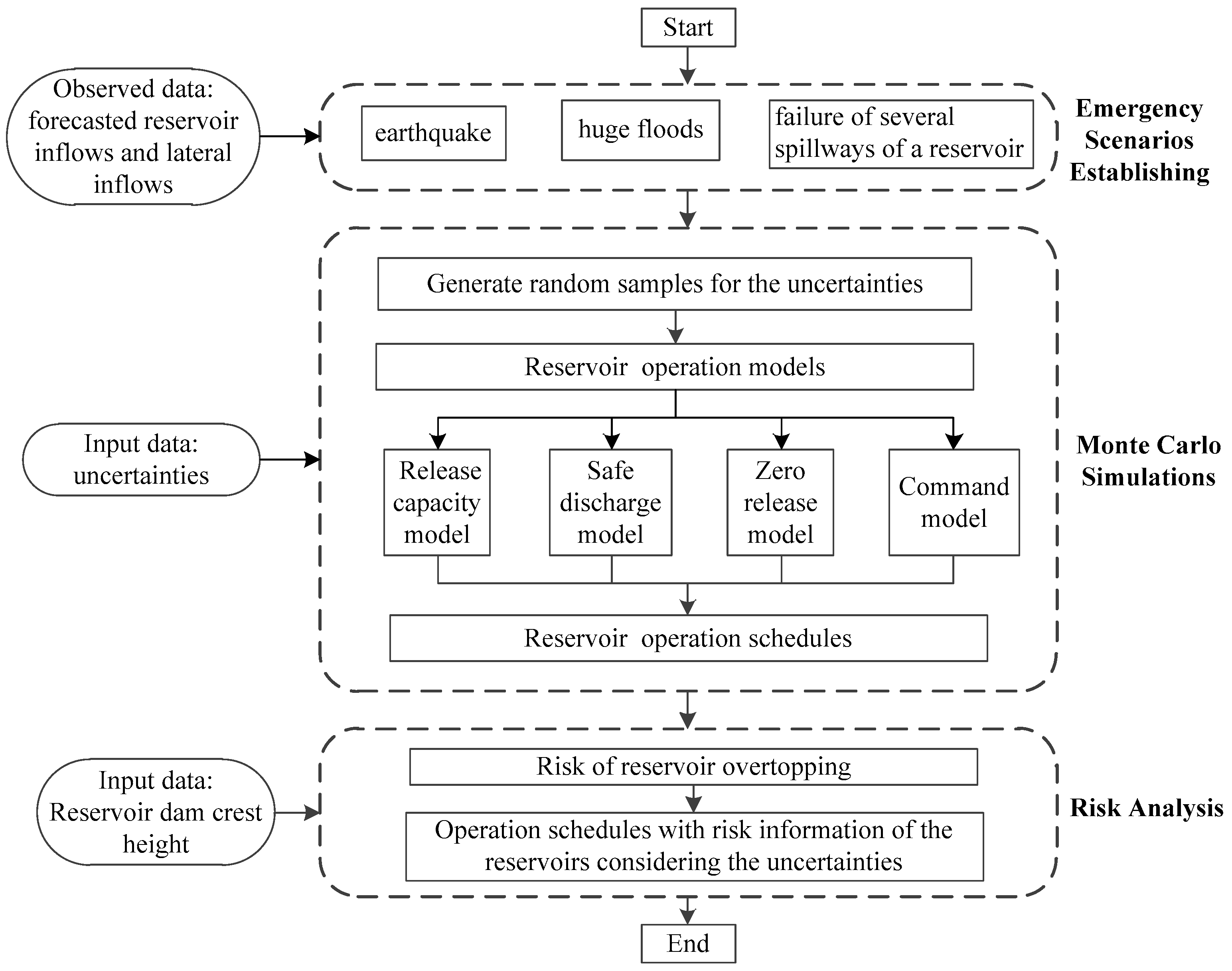
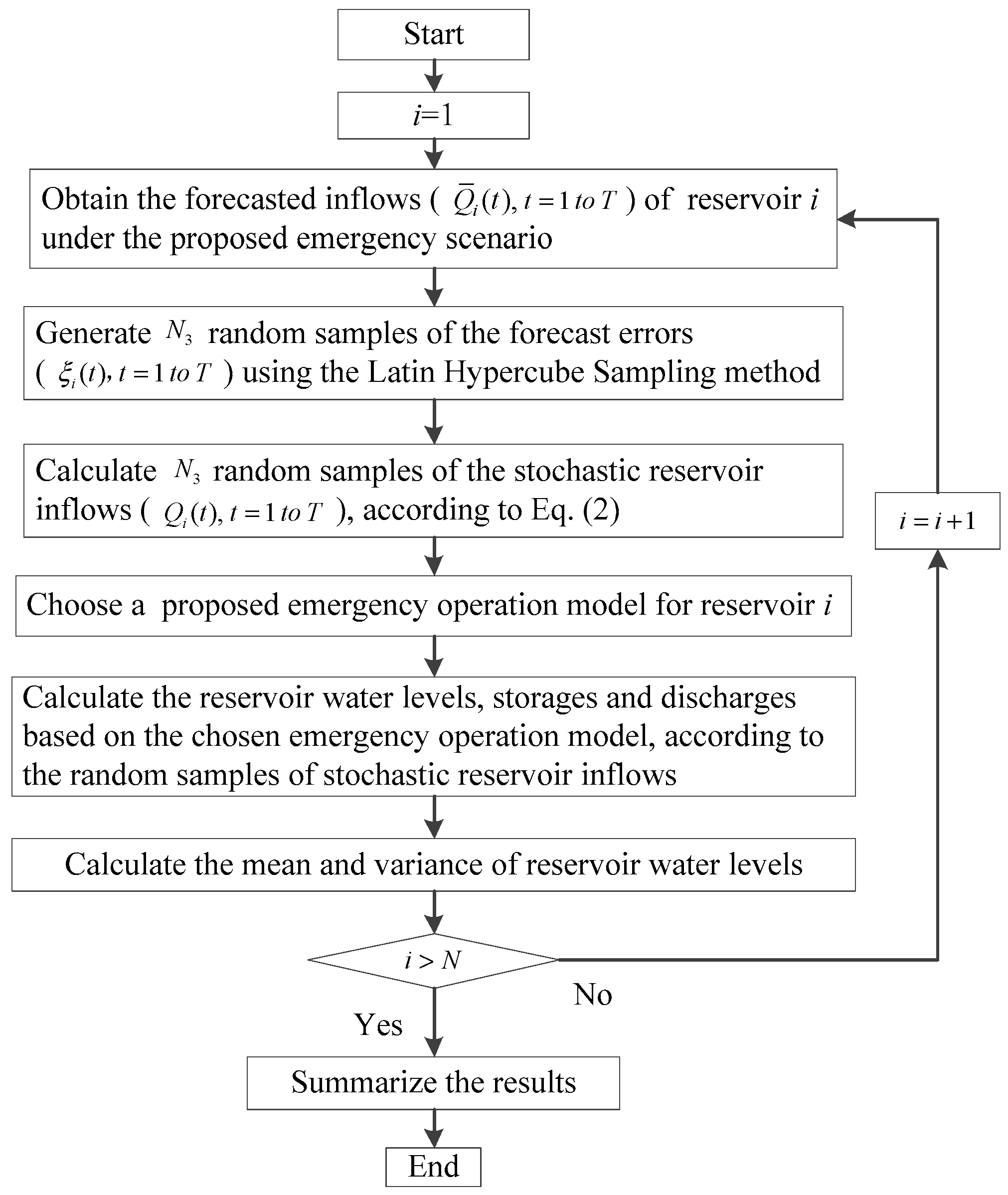
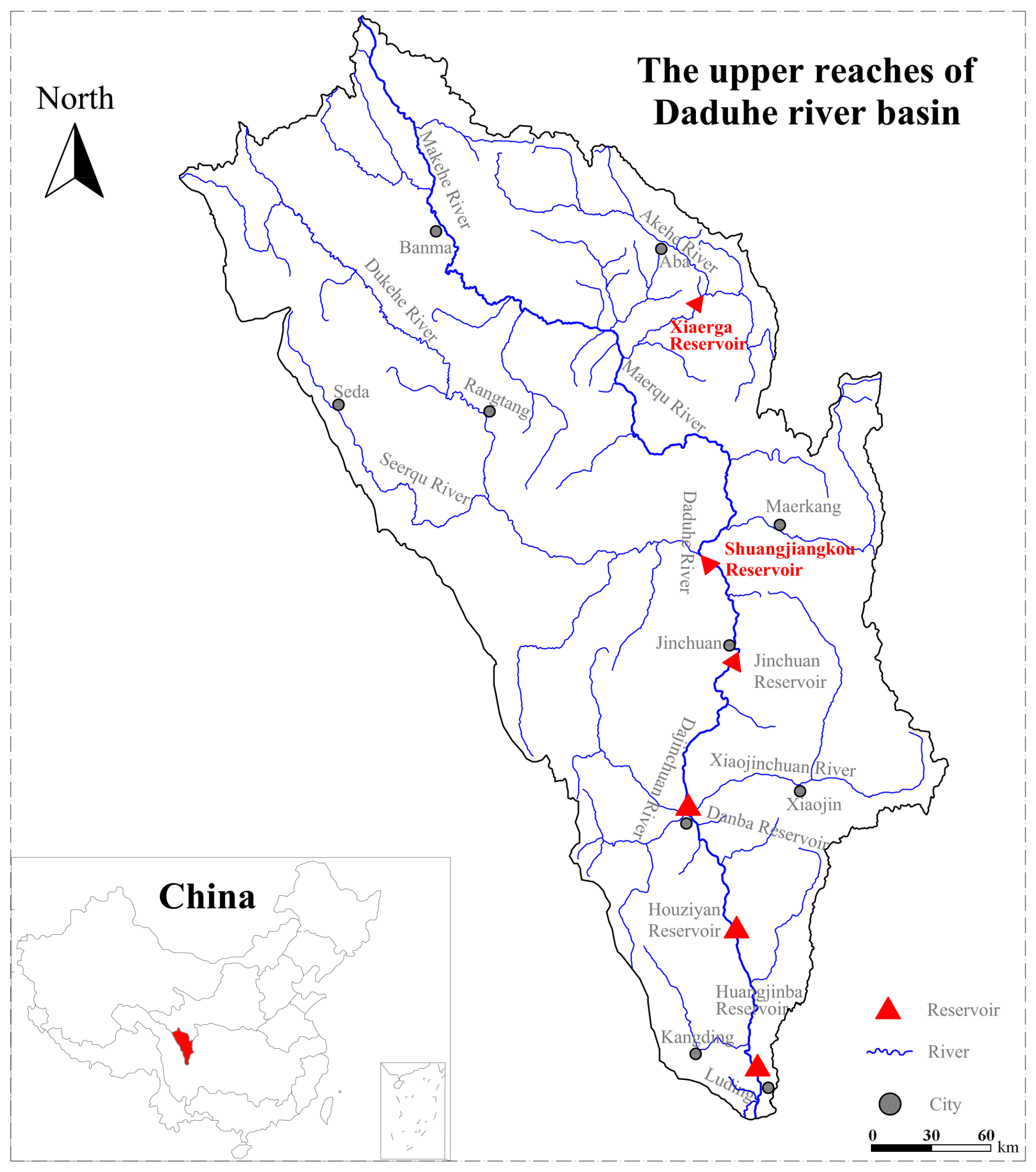
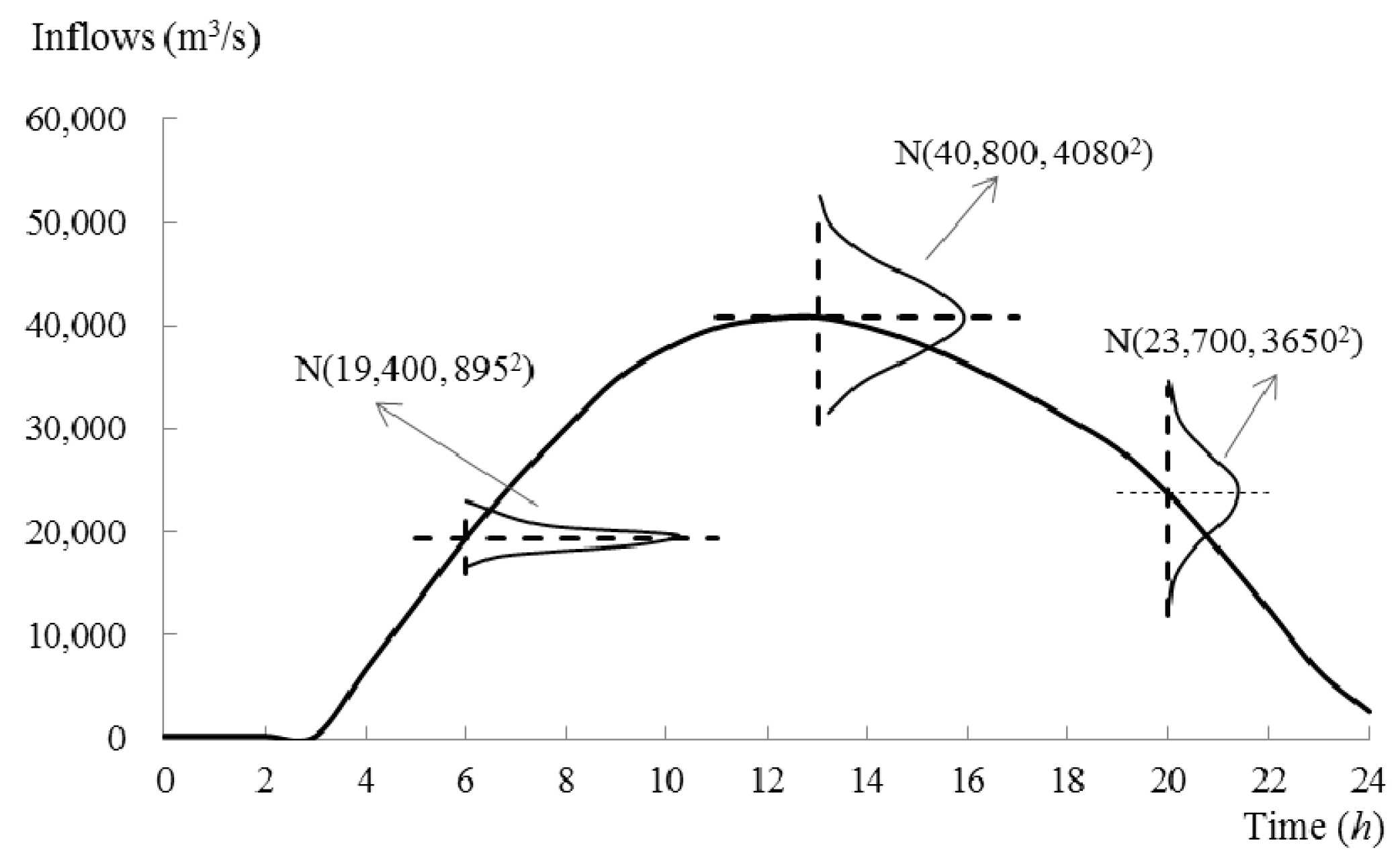
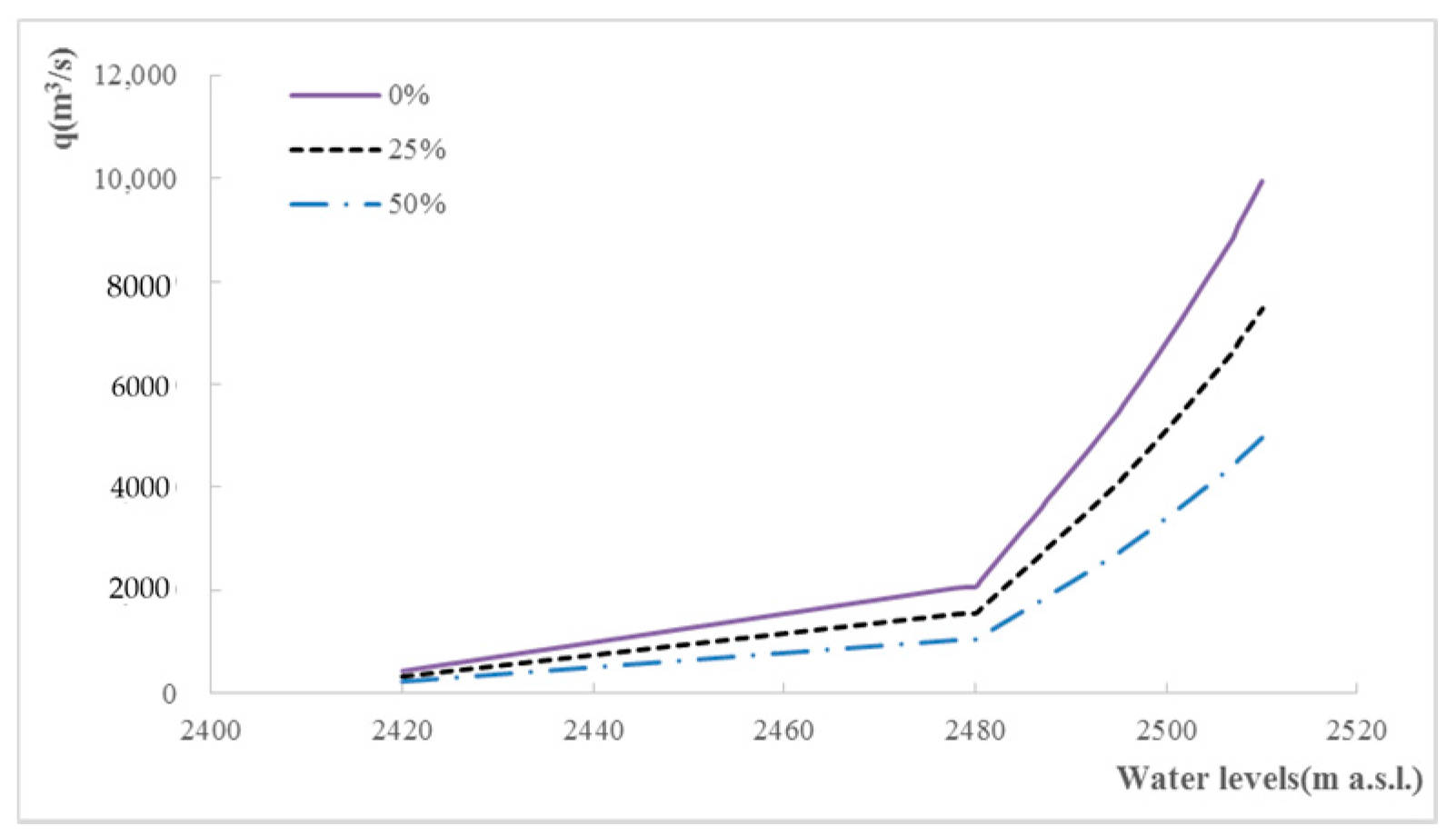
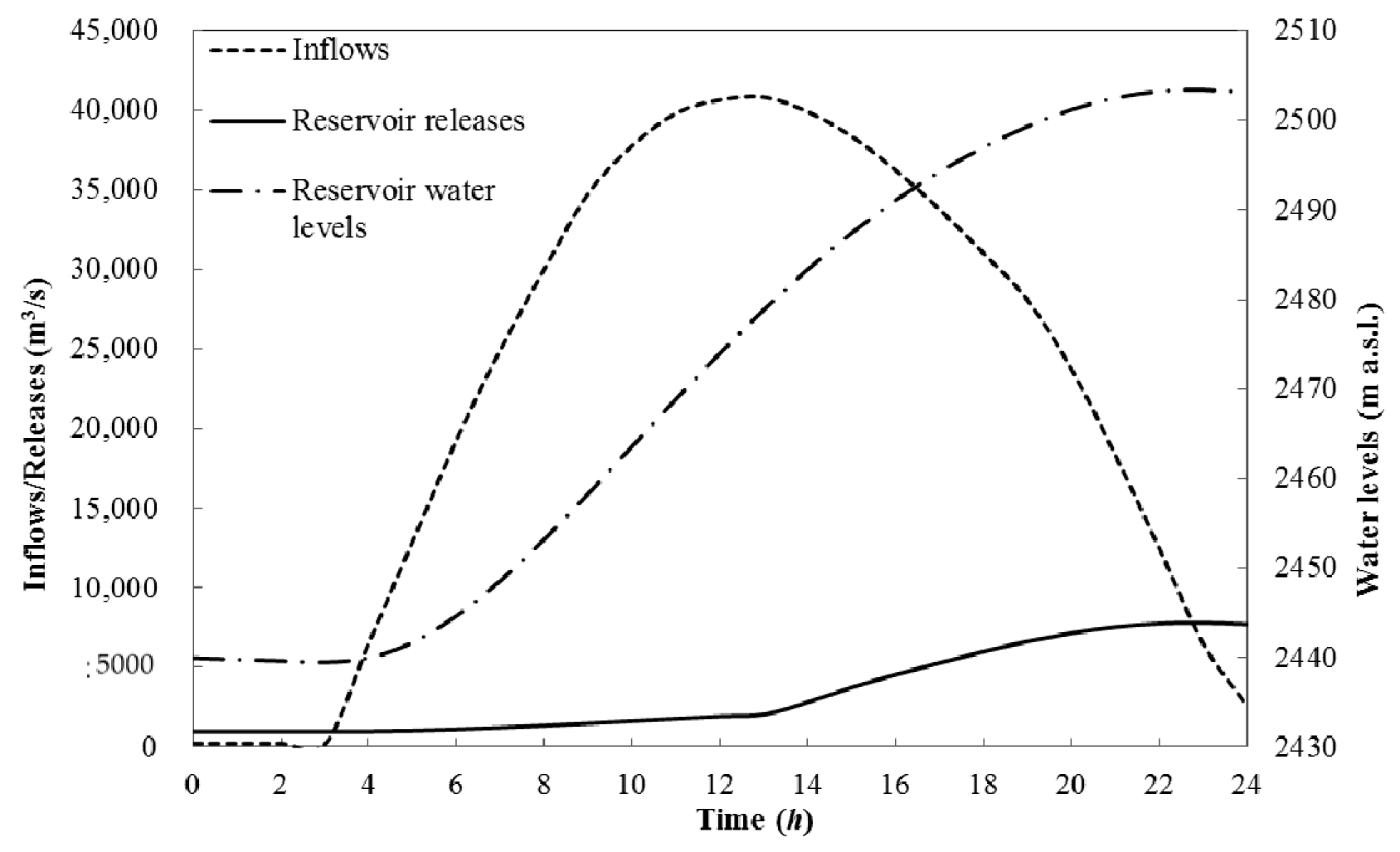
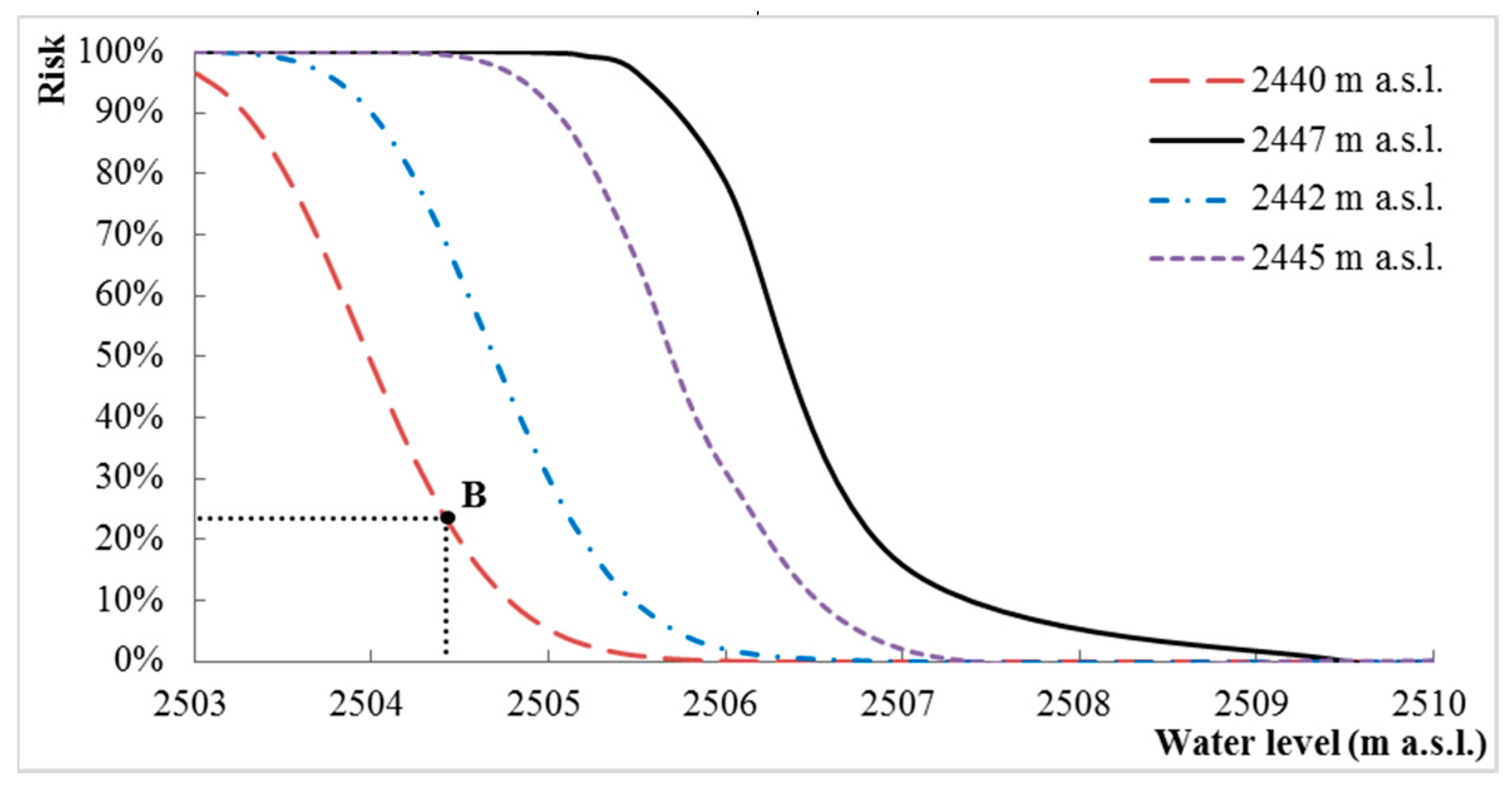
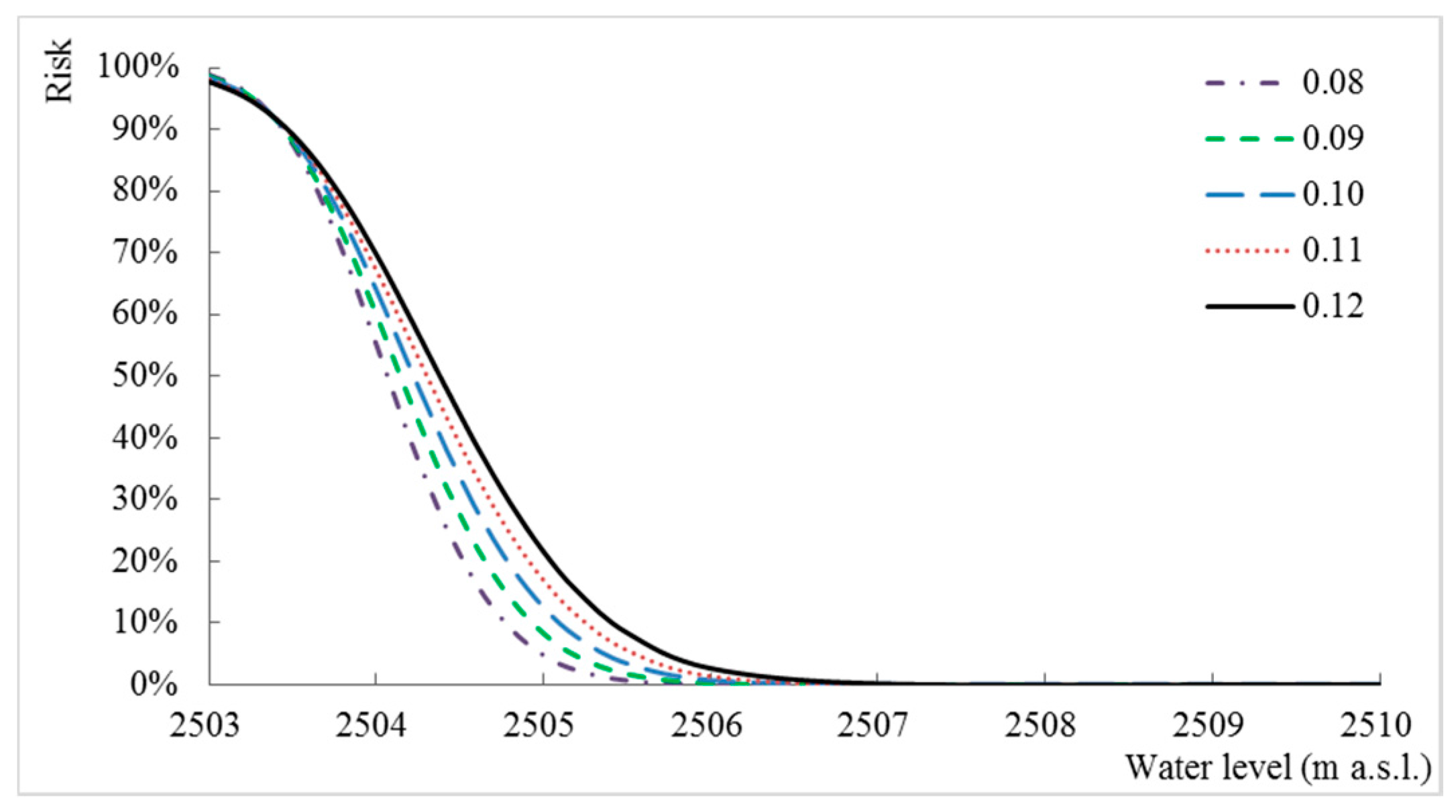
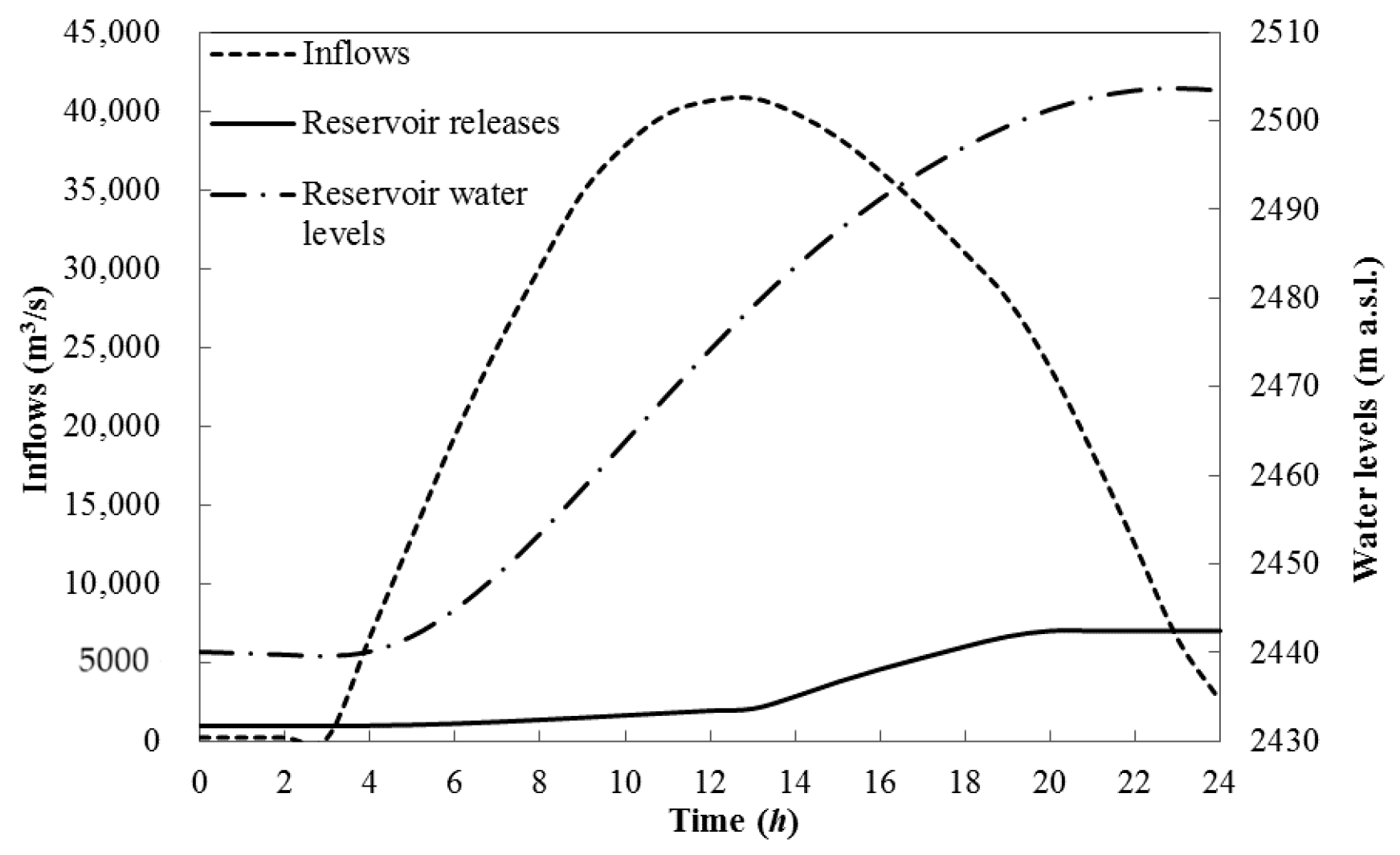


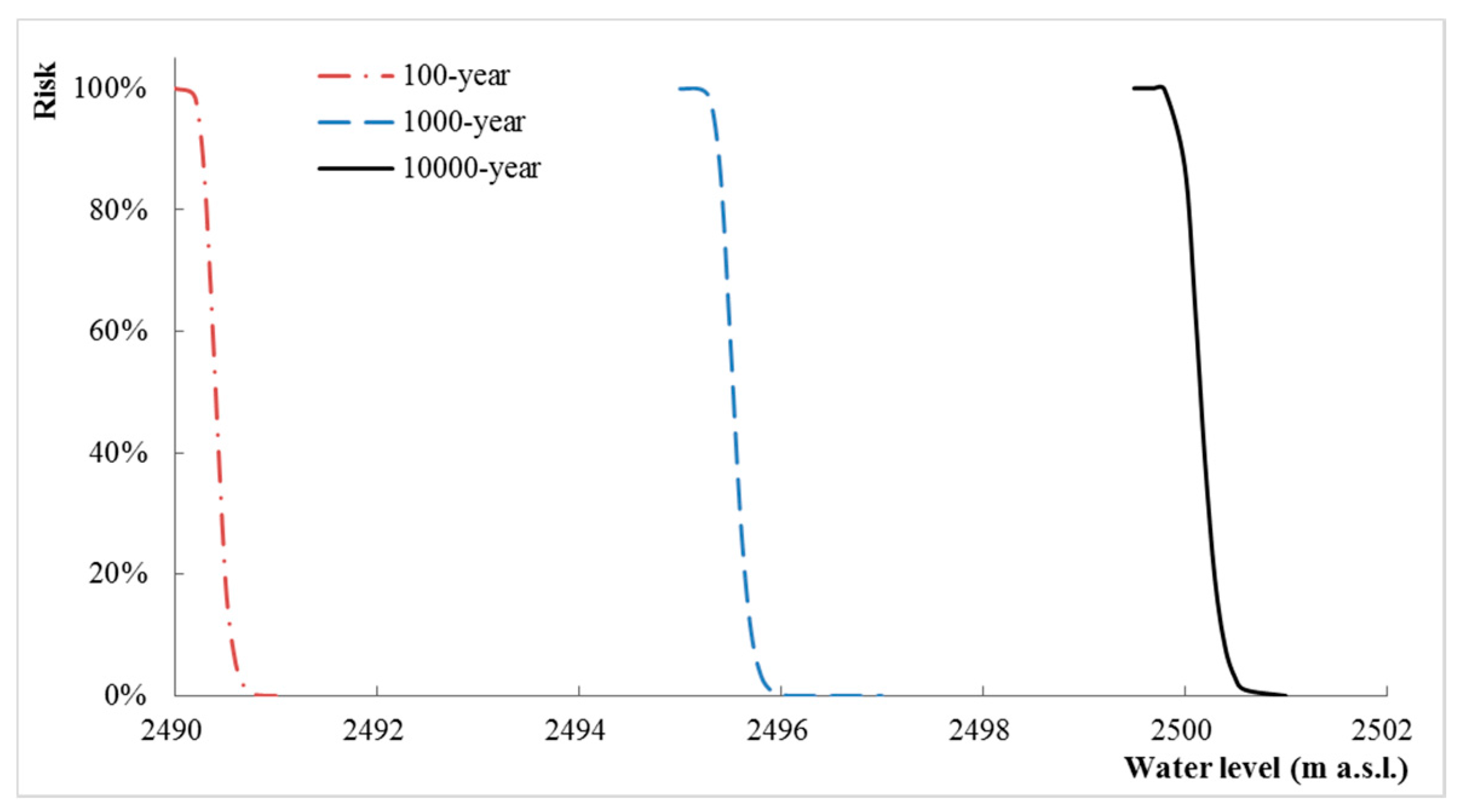
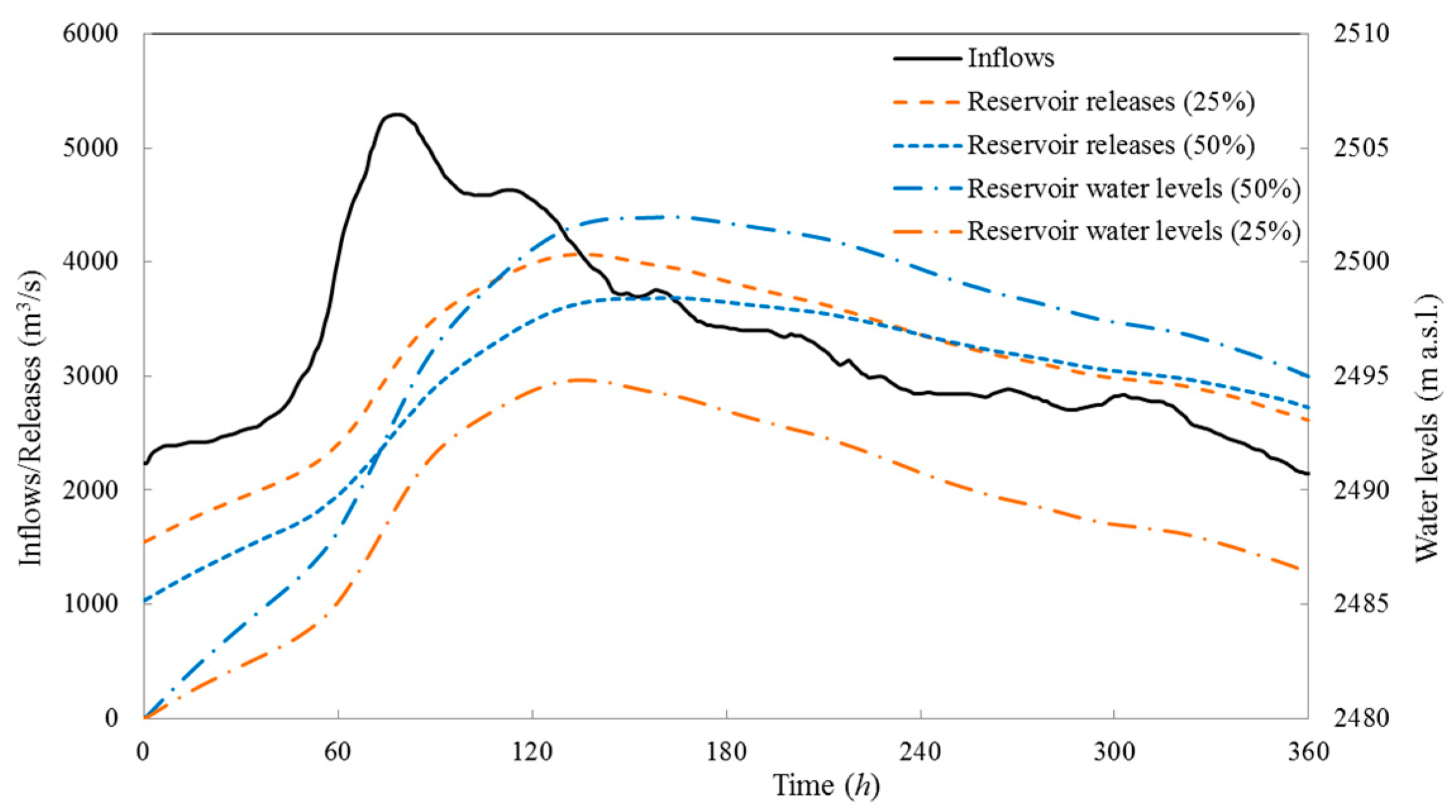

| Reservoirs | Xiaerga | Shuangjiangkou |
|---|---|---|
| River basin area (km2) | 15,500 | 39,330 |
| Annual inflows (m3/s) | 186 | 512 |
| Dam crest elevation (m a.s.l.) | 3175 | 2510 |
| Dam crest height (m) | 257 | 314 |
| Normal water level (m a.s.l.) | 3120 | 2500 |
| Flood control water level (m a.s.l.) | 3105 | 2480 |
| Dead water level (m a.s.l.) | 3060 | 2420 |
| Storage capacity (108 m3) | 28 | 31.15 |
| Installed capacity (MW) | 540 | 1800 |
| Time | Mean (m a.s.l.) | Standard Deviation (m) | Time | Mean (m a.s.l.) | Standard Deviation (m) |
|---|---|---|---|---|---|
| 1 | 2439.84 | 0.00 | 13 | 2478.95 | 0.64 |
| 2 | 2439.69 | 0.00 | 14 | 2483.45 | 0.69 |
| 3 | 2439.53 | 0.00 | 15 | 2487.50 | 0.72 |
| 4 | 2440.04 | 0.02 | 16 | 2491.13 | 0.75 |
| 5 | 2441.79 | 0.06 | 17 | 2494.31 | 0.80 |
| 6 | 2444.78 | 0.12 | 18 | 2497.03 | 0.80 |
| 7 | 2448.70 | 0.18 | 19 | 2499.37 | 0.83 |
| 8 | 2453.34 | 0.26 | 20 | 2501.22 | 0.82 |
| 9 | 2458.42 | 0.34 | 21 | 2502.53 | 0.83 |
| 10 | 2463.72 | 0.43 | 22 | 2503.28 | 0.82 |
| 11 | 2468.99 | 0.50 | 23 | 2503.44 | 0.81 |
| 12 | 2474.09 | 0.58 | 24 | 2503.13 | 0.79 |
| Time | Mean (m a.s.l.) | Standard Deviation (m) | Time | Mean (m a.s.l.) | Standard Deviation (m) |
|---|---|---|---|---|---|
| 1 | 2439.84 | 0.00 | 13 | 2478.95 | 0.64 |
| 2 | 2439.69 | 0.00 | 14 | 2483.45 | 0.69 |
| 3 | 2439.53 | 0.00 | 15 | 2487.50 | 0.72 |
| 4 | 2440.04 | 0.02 | 16 | 2491.13 | 0.75 |
| 5 | 2441.79 | 0.06 | 17 | 2494.31 | 0.80 |
| 6 | 2444.78 | 0.12 | 18 | 2497.03 | 0.80 |
| 7 | 2448.70 | 0.18 | 19 | 2499.37 | 0.83 |
| 8 | 2453.34 | 0.26 | 20 | 2501.23 | 0.83 |
| 9 | 2458.42 | 0.34 | 21 | 2502.58 | 0.86 |
| 10 | 2463.72 | 0.43 | 22 | 2503.38 | 0.88 |
| 11 | 2468.99 | 0.50 | 23 | 2503.62 | 0.88 |
| 12 | 2474.09 | 0.58 | 24 | 2503.38 | 0.89 |
© 2018 by the authors. Licensee MDPI, Basel, Switzerland. This article is an open access article distributed under the terms and conditions of the Creative Commons Attribution (CC BY) license (http://creativecommons.org/licenses/by/4.0/).
Share and Cite
Chen, J.; Zhong, P.-a.; Wang, M.-l.; Zhu, F.-l.; Wan, X.-y.; Zhang, Y. A Risk-Based Model for Real-Time Flood Control Operation of a Cascade Reservoir System under Emergency Conditions. Water 2018, 10, 167. https://doi.org/10.3390/w10020167
Chen J, Zhong P-a, Wang M-l, Zhu F-l, Wan X-y, Zhang Y. A Risk-Based Model for Real-Time Flood Control Operation of a Cascade Reservoir System under Emergency Conditions. Water. 2018; 10(2):167. https://doi.org/10.3390/w10020167
Chicago/Turabian StyleChen, Juan, Ping-an Zhong, Man-lin Wang, Fei-lin Zhu, Xin-yu Wan, and Yu Zhang. 2018. "A Risk-Based Model for Real-Time Flood Control Operation of a Cascade Reservoir System under Emergency Conditions" Water 10, no. 2: 167. https://doi.org/10.3390/w10020167




